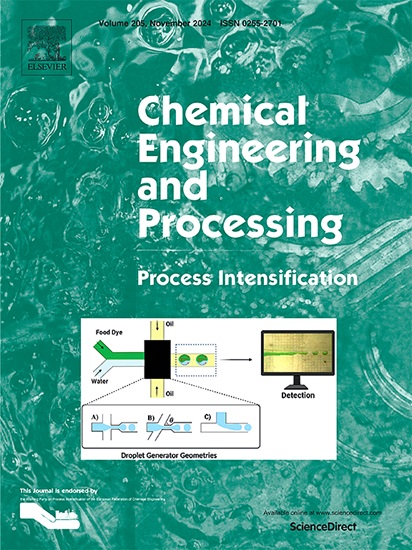Nanoparticle deagglomeration driven by a high shear mixer and intensification of low-speed stirring in a viscous system
IF 3.8
3区 工程技术
Q3 ENERGY & FUELS
Chemical Engineering and Processing - Process Intensification
Pub Date : 2024-11-26
DOI:10.1016/j.cep.2024.110092
引用次数: 0
Abstract
High shear mixers (HSMs), with their unique advantages of high shear forces and a wide operational range, are commonly used in nanoparticle deagglomeration. This study explores a novel approach to intensifying nanoparticle deagglomeration in a 100 mPa‧s viscous system using HSMs combined with low-speed stirring. The effects of main operating and structural parameters were experimentally investigated. The results show that the teethed HSM outperforms the blade-screen HSM, achieving a smaller attainable size (114 nm vs. 210 nm) and a higher fine particle generation fraction (46.08% vs. 18.77%). Increasing HSM size directly affects the energy input (from 6.478 MJ/kg to 31.879 MJ/kg), which influences the deagglomeration mechanism and kinetics but does not affect the smallest attainable size (117 nm). Higher solid contents improve energy efficiency, while low-speed stirring, though not altering the deagglomeration mechanism, enhances its kinetics. The process intensification factor (S) and energy efficiency factor (εm) were defined to evaluate the intensification of low-speed stirring. Increasing the impeller speed enhances this effect. The PBT impeller with a diameter ratio of 0.35 is identified as the ideal structure in this study, improving deagglomeration performance by 8.26% while reducing energy consumption by 8.3%. These results provide guidance for optimizing processes and improving deagglomeration performance through the combination of low-speed stirring in viscous systems for process industries.

高剪切混合器驱动的纳米颗粒脱团聚和粘性系统中低速搅拌的强化
高剪切混合器以其剪切力大、操作范围广等独特优点,广泛应用于纳米颗粒的解团。本研究探索了一种在100 mPa·s黏性体系中,利用高速搅拌结合低速搅拌强化纳米颗粒脱团聚的新方法。实验研究了主要操作参数和结构参数的影响。结果表明,齿状HSM的可达尺寸更小(114 nm vs. 210 nm),细颗粒生成率更高(46.08% vs. 18.77%)。增大HSM尺寸直接影响能量输入(从6.478 MJ/kg增加到31.879 MJ/kg),影响脱团聚机理和动力学,但不影响可达到的最小尺寸(117 nm)。较高的固含量提高了能量效率,而低速搅拌虽然不改变脱团聚机理,但提高了脱团聚动力学。定义了过程强化因子(S)和能效因子(εm)来评价低速搅拌的强化程度。提高叶轮转速可以增强这种效果。本研究确定直径比为0.35的PBT叶轮为理想结构,其脱团聚性能提高8.26%,能耗降低8.3%。这些结果为过程工业中通过低速搅拌系统的组合来优化工艺和提高脱团聚性能提供了指导。
本文章由计算机程序翻译,如有差异,请以英文原文为准。
求助全文
约1分钟内获得全文
求助全文
来源期刊
CiteScore
7.80
自引率
9.30%
发文量
408
审稿时长
49 days
期刊介绍:
Chemical Engineering and Processing: Process Intensification is intended for practicing researchers in industry and academia, working in the field of Process Engineering and related to the subject of Process Intensification.Articles published in the Journal demonstrate how novel discoveries, developments and theories in the field of Process Engineering and in particular Process Intensification may be used for analysis and design of innovative equipment and processing methods with substantially improved sustainability, efficiency and environmental performance.

 求助内容:
求助内容: 应助结果提醒方式:
应助结果提醒方式:


